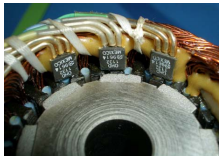Among the simplest and least expensive feedback devices are Hall-effect sensors. These are digital on-off devices that detect the presence of magnetic fields. Made of semiconductor material, they are rugged, can be operated at very high frequencies (equating to tens of thousands of motor rpm), and are commonly used to provide six-step commutation of brushless motors. They are well suited for torque control or coarse speed control, and simplify the drive electronics by directly switching the motor phase power devices. For you history buffs, the Hall effect was discovered by (yes of course) Edwin Herbert Hall in 1879 at John Hopkins University - and by the way - this happened to be 18 years prior to the discovery of the electron.
These digital on-off sensors detect the presence of magnetic fields, either by measuring the strength of an electromagnetic or permanent magnetic field. At each pass of a magnetic field they generate a pulse. Hall-effect devices come in stand-alone packages that are mounted within the servo motor housing. In brushless servo motors, these sensors are sometimes embedded in the stator windings and switched by the rotor magnets. These devices report the shaft's position, which can also be converted to speed or acceleration data.
In servo motor applications, the most common function for Hall devices is six-step commutation, a type of electronic commutation requiring relatively simple drive electronics. This may not suit some industrial servo applications because it can be less efficient at producing torque, and worse, can generate high torque ripple. In this case, torque ripple results from abrupt current transitions resulting in torque fluctuations, which usually produce minute but detectable speed variations. In some cases torque ripple can seriously deteriorate the overall performance of a drive system.
With sinusoidal current drives, Hall sensors may be used in combination with incremental encoder feedback to provide precision sinusoidal commutation. In servo drives, Hall sensors also function as current sensors to close the current loop. In other industry applications, they sense the position of crankshafts, cams, or other mechanical devices.

Kind of a neat device - simple, cost effective, and yet capable of contributing quite a lot to a feedback system! To find out more, we point you to one of our Two Minutes of Motion videos, staring Gordon Ritchie, to help break down the Hall device event further - Check it out!






